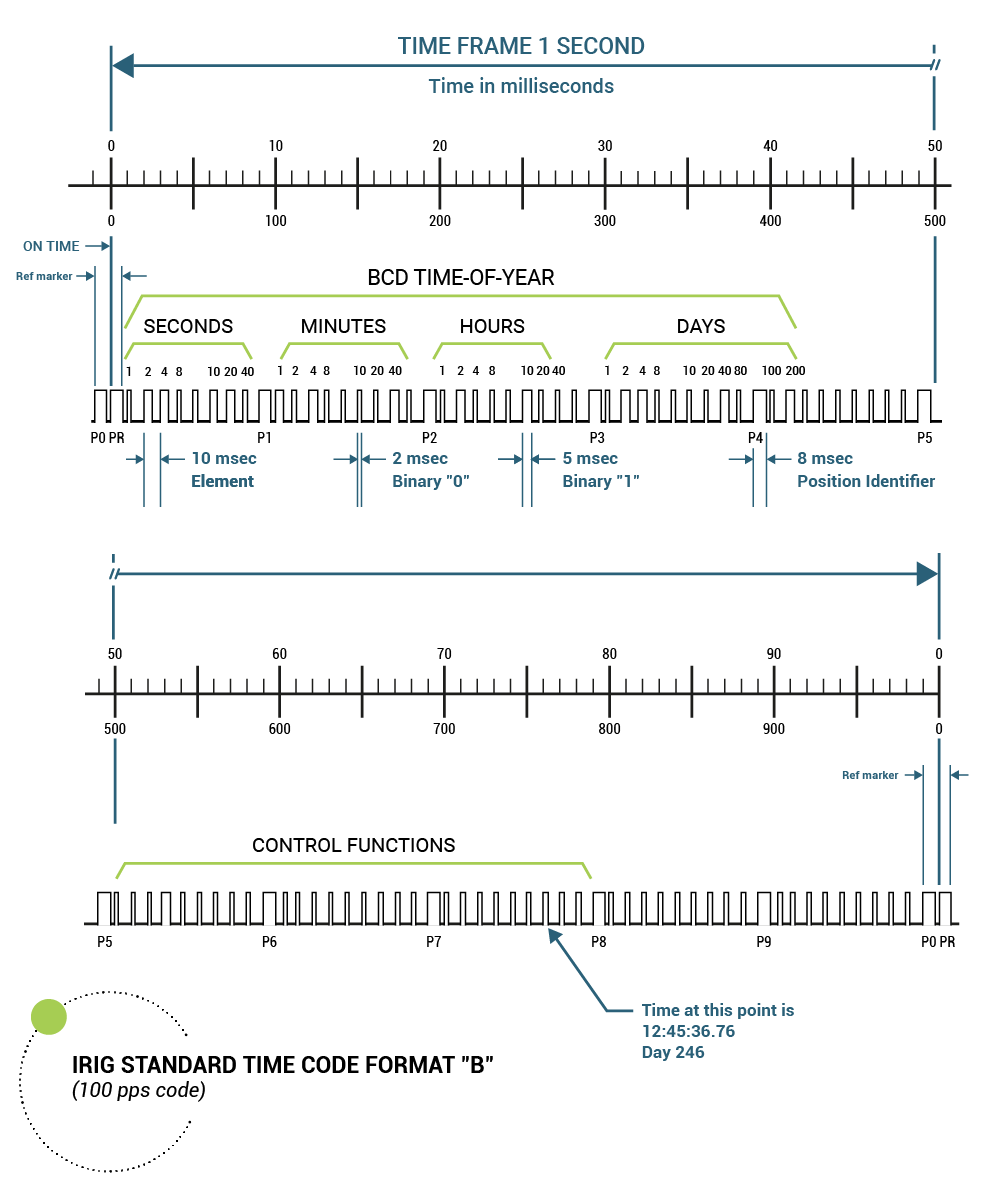Nowadays, there are many sectors for which each microsecond counts. It is actually the case for the defence, aerospace and the energy sector. As for the application of these sectors, IRIG (Inter-Range Instrumentation Group) is the most widely used time standard. Indeed, it offers reliability and accuracy to complex logistics operations. It also ensures measurement correction in critical telemetry systems.
It is often referred to as IRIG protocol. However, it is rather a family of encoding formats which defines how time information must be generated and distributed between different systems and devices. What is the IRIG standard and how to explore its different formats?
IRIG time standards
IRIG is a family of standards, standardised by the Range Commanders Council (RCC) in the 1950’s. Back then, the need was to synchronise all communications during missile testing. The first formal standards appeared in 1956. Today, the IRIG standard is still maintained by the RCC.
The purpose of these standards is to enable timestamping diffusion for synchronising different network equipment, as these needs are more and more increasing in both the civilian and military sectors. The devices are divided into two categories: the generators and the receivers. The generators carry out the timestamping whether directly, or by retrieving it from a source such as a GPS or an atomic clock. The receivers receive and potentially spread the data.
The latest IRIG standard dates back to 2004. A revision dating back from 2016 exists, but it only corrects some minor errors included in the previous standard.
IRIG time standards consist in sending timestamping information continuously in order to synchronise the different devices. IRIG time standards define electrical current encodings for transmitting timestamping frames. The IRIG standard operates by sending electrical pulses in a format that encodes the timestamping. This makes these standards particularly useful for use on short distances.
The different standards
There are numerous IRIG standards available.
A standard is defined by a combination of a letter followed by 3 numbers:
- The letter or format (A, B, D, E, G or H) represents the standard bit rate as well as the timestamping accuracy.
- The first number corresponds to the modulation used. It is included between 0 and 2.
- The second number indicates the standard carrier frequency. It is included between 0 and 5.
- The last number represents the possible variations in the content of the timestamping frame. It is included between 0 and 7.
It is not possible to make all combinations. Therefore, below is a summary table of defined standards:
| Format | Modulation | Support | Content |
|---|---|---|---|
| A | 0, 1, 2 | 0, 3, 4, 5 | 0,1,2,3,4,5,6,7 |
| B | 0, 1, 2 | 0,2,3,4,5 | 0,1,2,3,4,5,6,7 |
| D | 0, 1 | 0, 1, 2 | 1,2 |
| E | 0, 1 | 0, 1, 2 | 1,2,5,6 |
| G | 0, 1, 2 | 0, 4, 5 | 1,2,5,6 |
| H | 0,1 | 0, 1, 2 | 1, 2 |
A combination is generally used in a specific field. For example, IRIG 106 is the standard used for aeronautical telemetry.
The different formats
The different formats of the IRIG standards are referred to as A, B, D, E, G and H. The difference between these standards lies in the frequency of synchronisation pulses sent (the throughput).
What is the difference between the different formats of the IRIG standard?
- Standard A sends 10 frames per second at the speed of one bit per millisecond
- Standard B sends a frame per second at the speed of one bit every millisecond
- Standard D (the slowest one), sends a frame per hour at the speed of one bit per minute
- Standard E sends a frame every 10 seconds at the speed of one bit every tenth of a second
- Standard G (the fastest one) sends 100 frames per second at the speed of one bit every tenth of a millisecond.
- Standard H sends a frame per minute at the speed of one bit per second
Therefore, the choice of standard depends on the accuracy required and the acceptable offset between the different devices. There is no “better” format, but there is a most suitable format for a specific application.
| Format | Bit rate |
|---|---|
| A | 1000 PPS(1) |
| B | 100 PPS |
| D | 1 PPM(2) |
| E | 10 PPS |
| G | 10000 PPS |
| H | 1 PPS |
(1) PPS: Pulse per second
(2) PPM: Pulse per minute
The different modulations
There are 3 types of technical modulation.
| Format | Description |
|---|---|
| 0 | Pulse width coded without carrier (DCLS (1)) |
| 1 | Sine wave carrier (amplitude modulated) |
| 2 | Manchester modulation |
(1) DCLS: DC Level Shift
- 0. Pulse width modulation: An analogue signal is simulated using digital circuits. No carrier frequency since direct current is used.
- 1. Amplitude modulation: the amplitude of a sinusoidal signal is modified to encode information bits.
- 2. Manchester modulation: this last modulation type is a specific one. It has no DC component and uses signal transitions to transmit bit values. This method features many advantages: the possibility to be coupled to alternating current, a better signal-to-noise ratio, and easier decoding. This technique has been designed to operate over coaxial cables or fibre optics over short distances.
The different supports
In order to send the information, IRIG standards define the possible carrier frequencies. Not all frequencies are suitable for all encoding formats. For reference purposes, the following table shows the authorised frequencies for each format.
| Code | Carrier frequency | Resolution |
|---|---|---|
| 0 | / | Bit rate |
| 1 | 100 Hz | 10 ms |
| 2 | 1 kHz | 1 ms |
| 3 | 10 kHz | 0.1 ms |
| 4 | 100 kHz | 10 µs |
| 5 | 1 MHz | 1 µs |
The choice of the carrier frequency has an impact on resolution which directly affects the accuracy required for the application.
The different coded expressions
It is also possible to send different information in timestamping frames.
It is possible to encode the time of the year, sent in binary-coded decimal (BCDTOY), the year in binary-coded decimal (BCDYEAR), a control function (CF) left to the discretion of the user as well as the number of seconds elapsed during the day (SBS).
The last number of the 3-number sequence of the standard indicates the information encoded. The following table summarises the different possibilities.
| Code | Coded information |
|---|---|
| 0 | BCDTOY(1), SBS(2), CF(3) |
| 1 | BCDTOY, CF |
| 2 | BCDTOY |
| 3 | BCDTOY, SBS |
| 4 | BCDTOY, BCDYEAR(4), SBS, CF |
| 5 | BCDTOY, BCDYEAR, CF |
| 6 | BCDTOY, BCDYEAR |
| 7 | BCDTOY, BCDYEAR, SBS |
(1) BCDTOY: time in binary-coded decimal (HH,MM,SS,DDD)
(2) SBS: number of seconds elapsed during the day
(3) CF: control function or checksum
(4) BCDYEAR: year in binary-coded decimal
The specific case of IRIG B
The IRIG B standard family is the most widely used format. It sends frames of 100 bits every second.
The below illustration features an IRIG B frame as it is modulated on an electrical signal.

What are the applications of the IRIG standard?
The IRIG coded time is still being used, and many applications are available:
- Defence systems. Military operations rely on synchronisation for coordinating the movement of troops, the deployment of weapon systems, and collection of information.
- Aviation. IRIG is generally used for telemetry.
- Power plants and energy networks. IRIG is used to synchronise protection relays, SCADA systems and disturbance recorders to ensure network integrity and reliability.
- Telecommunications. Even if protocols such as NTP and PTP are more commonly used in telecommunication networks, IRIG is sometimes used in infrastructures.
- Audiovisual sector. IRIG can be used to synchronise audio and video recorded by different devices.
- Video surveillance systems. IRIG is used to timestamp videos, which can serve as legal evidence.
- Transport sector. Logistics control systems can use IRIG for synchronising signals, recordings, and security systems.
Many applications are available, despite the emergence of new technologies and new synchronisation protocols. IRIG remains an essential standard for applications requiring high-precision synchronisation.
With more than 150 years of expertise in time management and present in more than 140 countries, Bodet Time is a major French leader in time synchronisation and time frequency. The range of Netsilon time servers offers IRIG time code generators and receivers.

